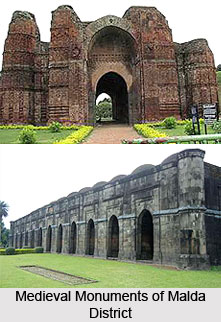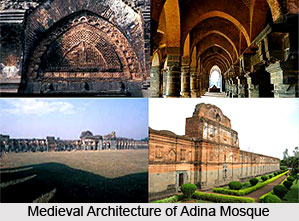 History of Malda District traces back, the whole tract of Malda is covering the extensive landscape including the areas of Tar, Diara and Barind. There is a mention of the Gourpura town in the account of Panini and the relics of the Gour kings in the region indicates the history of Malda is as old as the Gaur Kings in Bengal. The ancient history of Malda, recounts that the entire region of Malda (Gour and Pandua) was a part of the kingdom of Pundravardhana. These two cities -Gour and Pandua being the most prosperous cities used to be the capital of Bengal in the ancient and the medieval times. Finally these two cities with the agglomeration of the English Bazaar Town constitute the present district of Malda.
History of Malda District traces back, the whole tract of Malda is covering the extensive landscape including the areas of Tar, Diara and Barind. There is a mention of the Gourpura town in the account of Panini and the relics of the Gour kings in the region indicates the history of Malda is as old as the Gaur Kings in Bengal. The ancient history of Malda, recounts that the entire region of Malda (Gour and Pandua) was a part of the kingdom of Pundravardhana. These two cities -Gour and Pandua being the most prosperous cities used to be the capital of Bengal in the ancient and the medieval times. Finally these two cities with the agglomeration of the English Bazaar Town constitute the present district of Malda.
According to the ancient history of Malda, the core part of Malda, Gour had experienced several changes in its boundary and structure since 5th century until it was annexed with the Mauryan Empire. During the time of Mauryas, Pundravardhana survived as their provincial capital with Gour as the nerve centre. The ancient history of Malda as deciphered from the Brahmalipi seal and the ruins of the Mahastangarh in the Bogura district of Bangladesh reveals the fact that Gour and Pundravardhana were the major parts of the Maurya Empire and the principal sites to carry out trade in the Middle East and the South East Asia. The Chinese pilgrim, Hiuen Tsang`s accounts also throw lights to the ancient history of Malda.
The Guptas when overpowered the Mauryas, the entire region of North Bengal came under the sway of the Guptas. Consequently the kingdom of Pundravardhana became the part of the Gupta Empire. The Allahabad Pillar inscription of Samudragupta clearly indicates that the entire region of North Bengal as far as the east upto Kamrup was incorporated with the Gupta Empire. From the evidence narrated in the Allahabad inscription, Pundravardhana existed as the key site of trade even in the history of the Gupta era in Malda.
After the Guptas the beginning of the 7th century in Pundravardhana is marked with the rise of Sasanka in the history of Malda. Sasanka, the most potential King ever been in Bengal since its advent. Sasanka, originally the king of Kanvasuvarna, occupied the extended area of Gaur and retained his sovereignty for a span of long three decades. However Sasanka had to forfeit to the vigorous Pala Kings, who constitute the pages of Malda`s history from 8th century to the 11th century.
The Pala kings were the staunch Buddhist who propagated Buddhism in Bengal. Hence many Viharas grew up in the extended part of Barind paralleling the Nalanda, Vikramsila and Devikot. The ancient history of Malda therefore narrates the existence of the Buddhist cults and customs in Malda.

Once the violent Pala kings yielded before the Senas who ascended the throne of Bengal in the 11th century. The Senas were strictly Hindus and they patronized the propagation of the Hindu religion only. Unlike the Palas, the Senas did not encourage the propagation of the other religions. The ancient history of Malda narrates the significance and the customs of the Hindu religion flourished in Bengal during the Sena imperialism. During the reign of Lakshman Sena, the kingdom of Gaur was identified with the name of the king and was known as Lakshanabati.
The indigenous kings, till the end of the 12th century ruled the region of Bengal. But the incompetent successors of Sena could not retain the former glory of the Senas once they earned in Bengal. Finally, in 1204, the Muslim ruler, Bakhtiyar Khalji invaded and conquered Bengal.
As far as the ancient history of Malda is concerned, the Muslims were the sole domineer of entire Bengal till the British chief Lord Clive defeated Siraj-ud-daulah in 1757 in the battle of Plassey and initiated the British regime in Bengal as well as India. The modern history of Malda was inaugurated by the emergence of the British as the imperial head across India. When the British occupied India, with the control over the entire Bengal, the district of Malda was formed encompassing the comprehensive areas of Purnia, Dinajpur and the Rajshahi districts in 1813. At the time of Doctor BG. Hamilton, the present thanas of Gazole, Malda, Bamongola and some parts of the Habibpur district were included in the entire district of Dinajpur. In 1813, due to the increasing crimes in Kaliachak and Sahebgunj, separate deputy collector and a Joint Magistrate were appointed in English Bazaar area, due to its close proximity with these two disturbed areas. Thus these two regions and the other areas of Malda, integrated with the English Bazaar and present district of Malda came into existence. The history of Malda witnessed a change with the establishment of treasury in 1832 and survived as a full-fledged British administrative unit with the posting of a magistrate and collector.
The period of British history of Malda, points out, Malda served as the part of Rajshahi and Bhagalpur till 1905. During the partition of Bengal plan in 1905, Malda was decided to incorporate with the areas of East Bengal and Assam. But finally through a declaration of the Radcliff Award, in 17th August 1947 the district of Malda was attached with the areas of West Bengal. However the Nawabganj subdivision though served from the area of Malda, was given to East Pakistan as a subdivision of the Rajshahi district.
With the emergence of the Gaur kings in Malda, the history of Malda on looks the downfall and the uprising of various dynasties and civilizations till it was concluded by the British imperialism in India.






